
Mid-Autumn Festival is just around the corner and it’s that time of the year that families start to buy or make their favorite mooncakes. In the past, the baked traditional mooncake was the staple to celebrate the festival. But these days, there are many different types of modern mooncakes that people love to enjoy. For example, these round pastry mooncakes filled with red bean paste and salty duck egg yolks.
Today, I want to share this snow skin mooncake with a custard filling recipe. Snow skin mooncake is a new type of mooncake that’s gradually gaining popularity in recent years.
What is a snow skin mooncake?
“Snow Skin” is translated from the Chinese “Bing Pi” (literally meaning “Icy Skin”). The word snow is used because of the color and texture of the mooncake wrapper. Different from the traditional baked sugary pastry, the snow skin mooncake is made with a mochi-like dough and usually served chilled. Sometimes people also call it a mochi mooncake.
Just like regular mooncakes, snow skin mooncakes can be filled with red bean paste, black sesame paste, lotus seed paste, and other sweet fruity fillings.
In this recipe I will be using a custard filling. Buttery, milky and creamy, it’s one of my favorite fillings to enjoy snow skin mooncake.
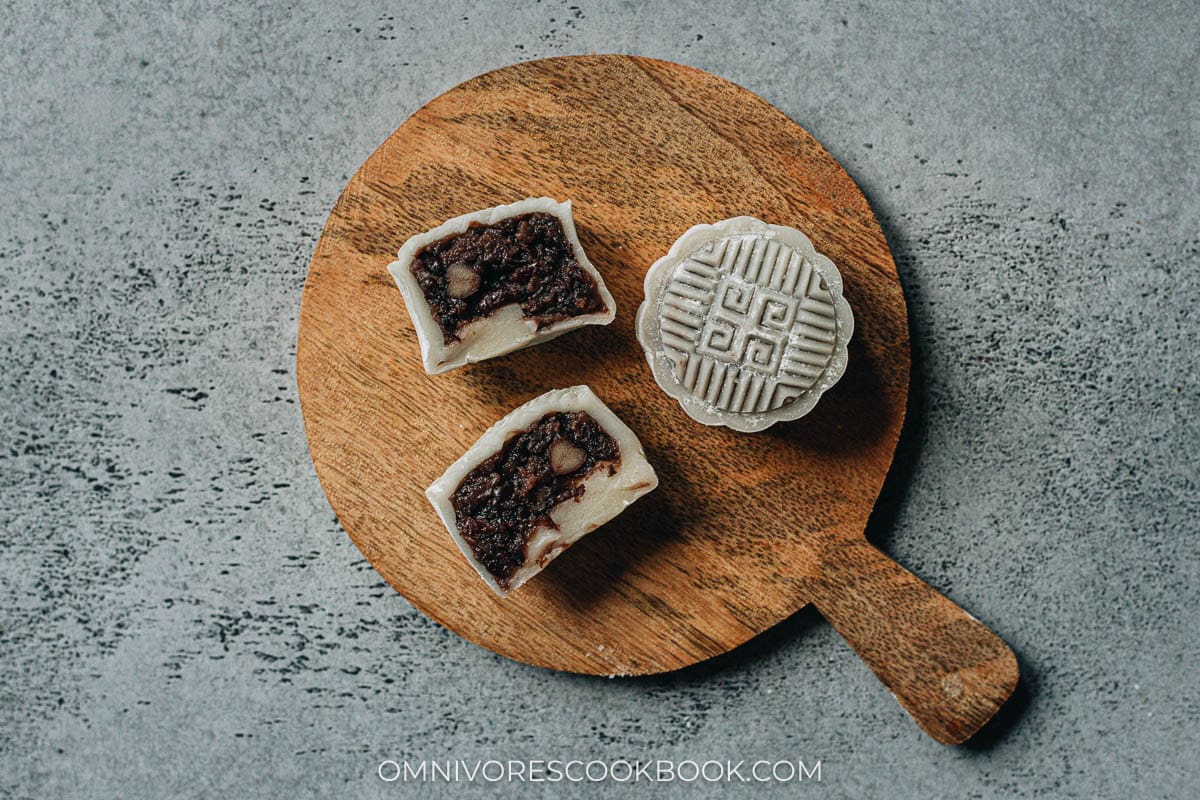
How to make snow skin mooncake
1. Prepare the custard filling
This recipe uses a standard custard recipe as the base. It contains more flour than regular custard so it is easy to form the mooncakes.
It uses 7 ingredients that are shown in the picture below.
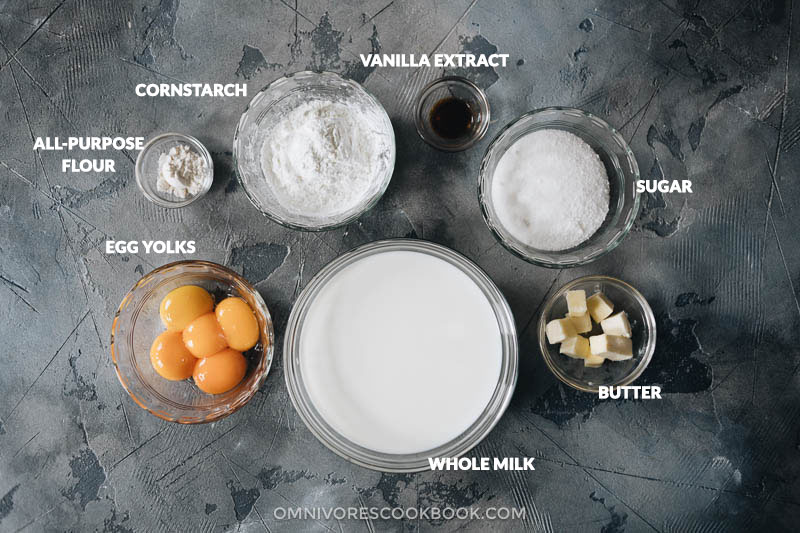
The workflow is:
- Mix the dry ingredients
- Heat up the milk and half of the sugar until warm
- Mix the egg yolks with the dry ingredients
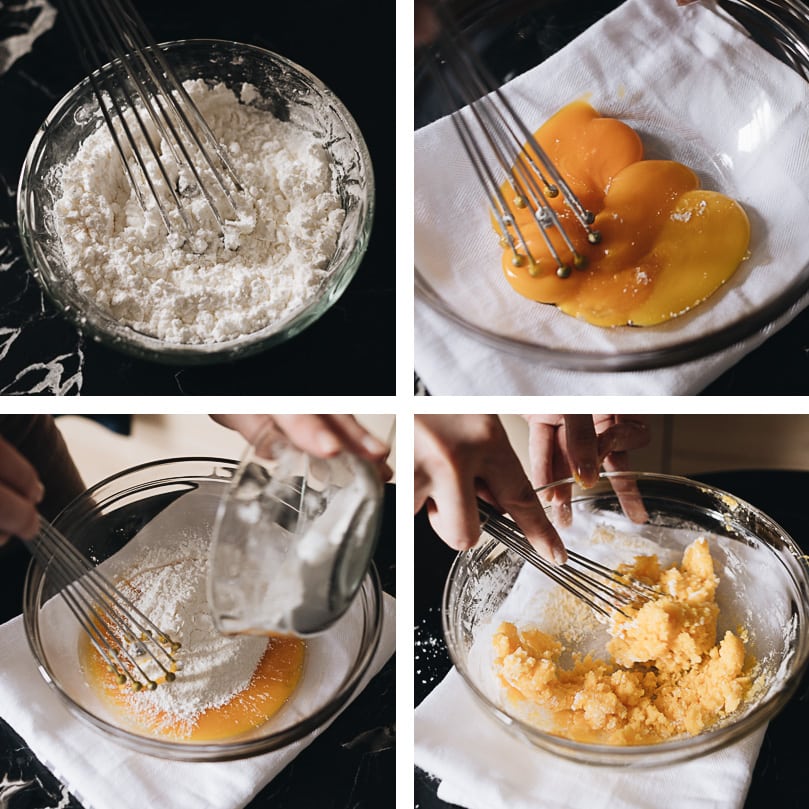
- Add the milk into the egg yolk and flour mixture
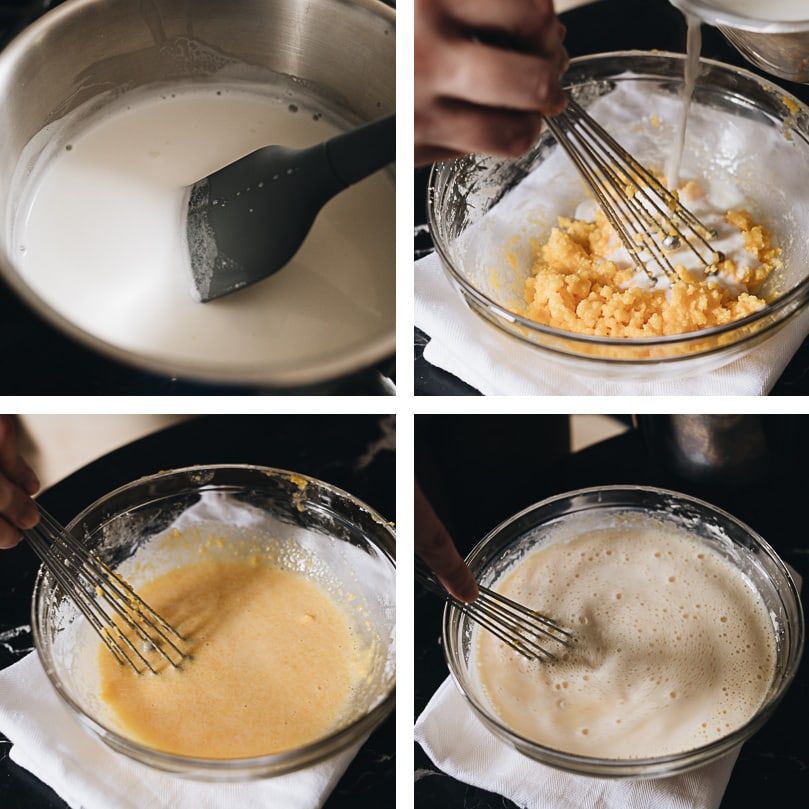
- Cook the mixture until it thickens
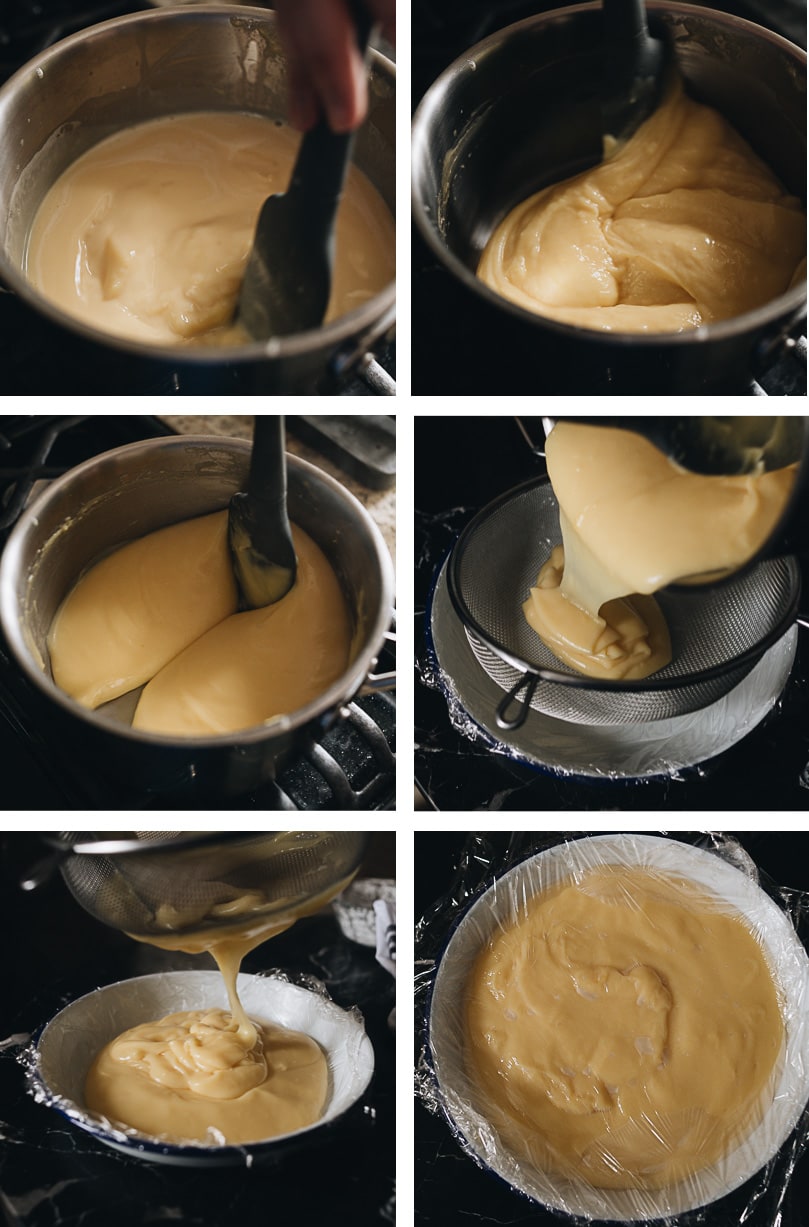
- Chill the custard in the fridge
Note:
- Make sure you don’t overheat the milk, otherwise it will cook the eggs and make the filling into a lumpy soup. I usually use a thermometer to make sure the milk doesn’t heat over 150 F (65 C). If you do not have a thermometer, you should heat up the milk over low heat until it’s warmed up but not too hot if you put your finger into the milk.
- Do not mix the egg yolks with the dry ingredients before you heat up the milk. The sugar will cook the egg yolk and change its texture if added too early.
- Stir the custard constantly when you heat it up on the stove. The mixture will be very runny at the beginning and will take a few minutes to cook. But once it starts to thicken, it happens very fast, like flipping a switch.
- Once the custard starts to bubble, make sure to stir constantly and let it cook boiled for 1 full minute. This will make sure the flour is cooked thoroughly, so the custard will be able to thicken up once chilled.
- Chill the custard completely before forming the mooncake. The texture will harden and become possible to shape once cooled.
2. Prepare the dough
The dough uses 7 ingredients that are shown in the picture below.
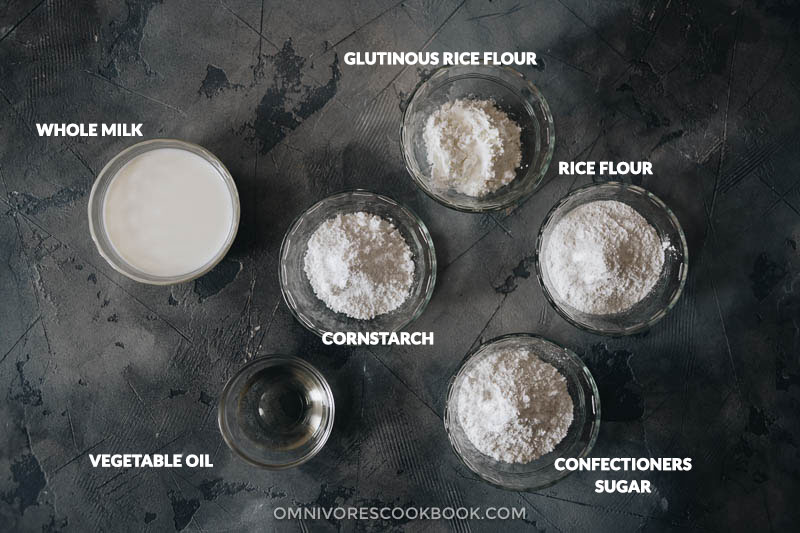
The workflow is:
- Combine the dry ingredients
- Combine the wet ingredients
- Mix the dry and wet ingredients into a very runny batter
- Steam the batter until cooked through

- Knead the cooked batter into a dough ball
- Chill the dough ball in the fridge
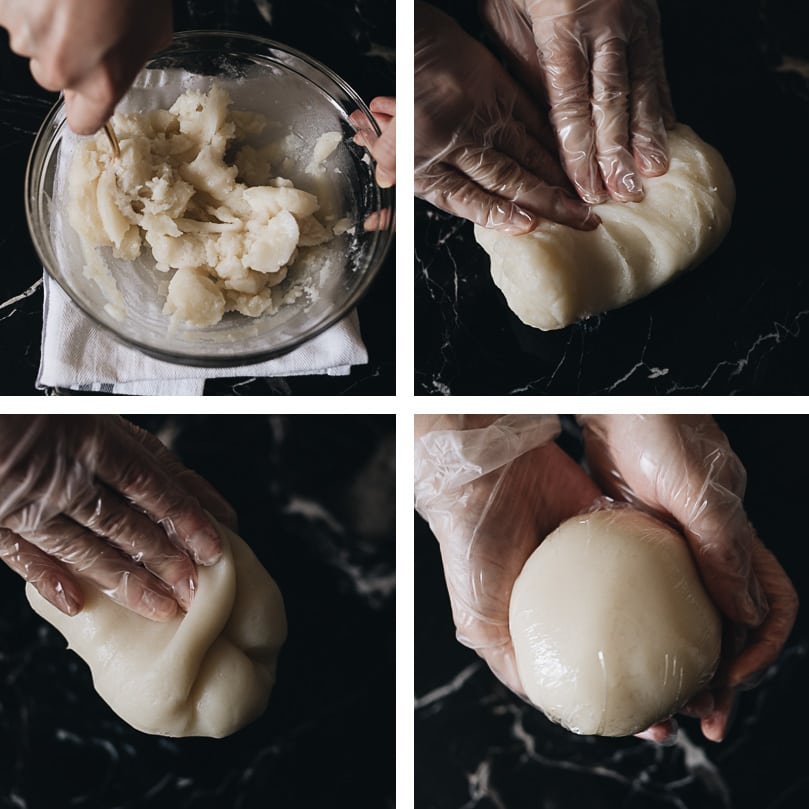
Note:
- You can add different extracts into the dough. Almond, rose, and pandan extracts all work in this recipe.
- You can add food coloring into the dough. Many recipes use a few drops of red or green food coloring to make pink and pale green mooncakes.
- Knead the dough once it’s steamed. The texture of the dough will soften a lot and become more palatable once kneaded.
- Chill the dough in the fridge for at least 30 minutes, so it hardens up a bit for the molding.
- It’s possible to make the dough ahead of time and chill it overnight. But we’ve found that the freshly made dough is easier to mold and tastes slightly better.
3. Make dough and filling balls
Once you’ve chilled the custard, mix it well with a spatula. This will help the custard to even out and make it easier to shape.
You might find the custard is quite soft and stick to your hands when shaping them. I highly recommend wearing a pair of disposable gloves, and slightly grease it with oil. It will make the custard much easier to shape.
Shape the custard and the dough into balls. And once you shape the custard into balls, immediately cover with plastic wrap and store in the fridge so it stays cool and firm.
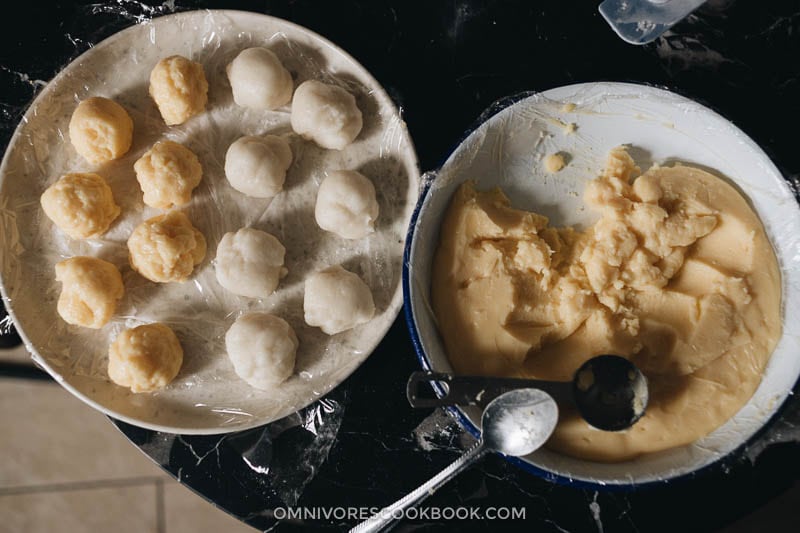
The easiest and most consistent way is to use a scale to measure out the portions. But if you don’t have a scale, you can use a tablespoon to measure one round tablespoon of dough and one round tablespoon of filling.
In this recipe, I used 25 grams of filling and 25 grams of dough. For the dough, I measured out a bit more dough to make a larger wrapper, so it’s easier to assemble the mooncakes. Once you wrap the mooncake, it will form more dough on top where you seal the filling. You can pinch off the extra dough so the mooncake skin will be even and thin throughout. It eventually makes a 45-gram mooncake (25 grams of filling + 20 grams of dough).
4. Assemble the mooncakes
To assemble the snow skin mooncakes, you need to:
- Roll a dough ball into a thin wrapper.
- Wrap the filling like you would wrap a dumpling (sort of).
- Pinch off the extra dough formed on top of the filling.
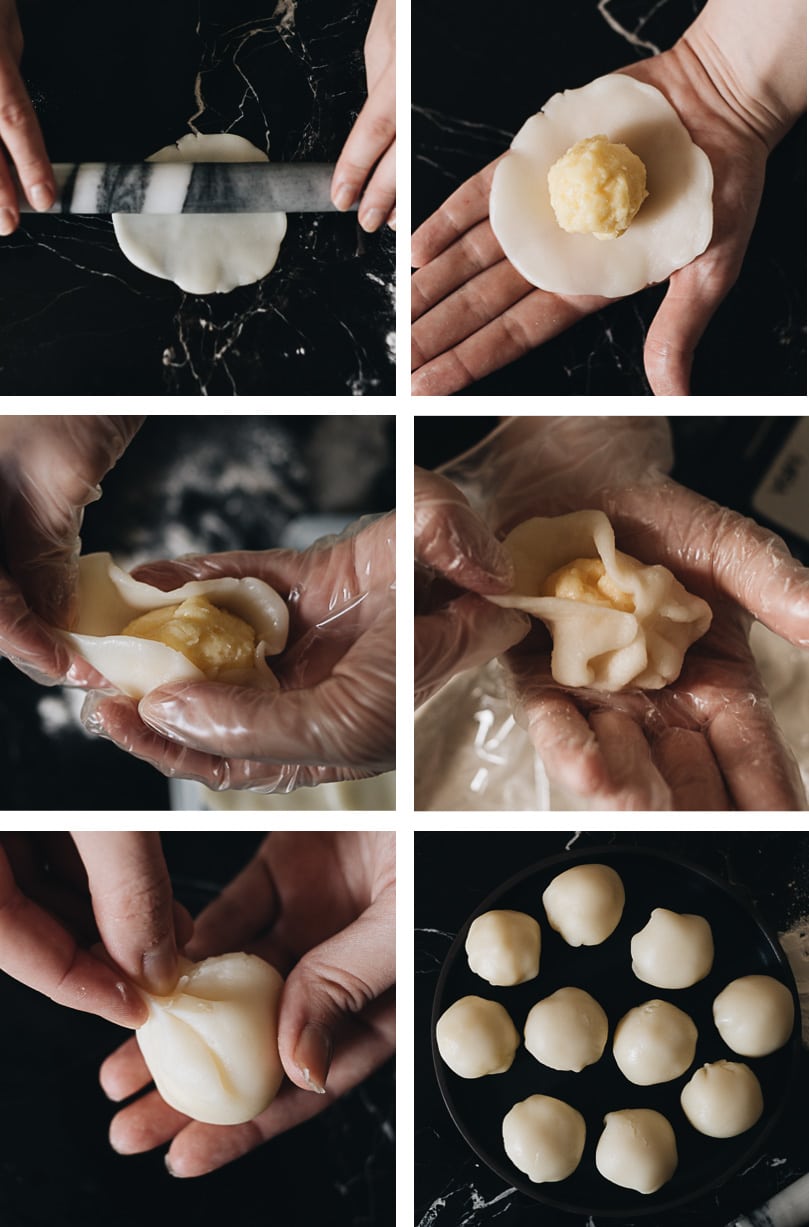
Note:
- You can use your hands to form the wrapper as well. Although I found that a rolling pin yields a thinner and more even wrapper.
- Do NOT dust your working surface with extra flour. The dough contains enough oil so it won’t stick to your working surface easily. Adding extra flour will change the texture of the dough.
- You can wear a pair of disposable gloves when you work on the mooncakes. Personally I like to shape the dough using my hands.
5. Mold the mooncake
To speak the truth, the “mochi” you’ve made at this point is kinda ready to eat and tastes delicious. But of course, you’ll need to mold them into beautiful patterns to call them mooncakes.
To make this happen, you need a mooncake mold. The traditional ones are made of carved wood. But I found that plastic molds are easier to source and quite easy to use. You can find them in Asian markets or on Amazon.
To mold the mooncake, you need to:
- Dust the assembled ball with a thin layer of cornstarch.
- Fit the ball into the mooncake mold and press for 30 seconds.
- Release the mooncake and pray that it comes out perfectly without falling apart.
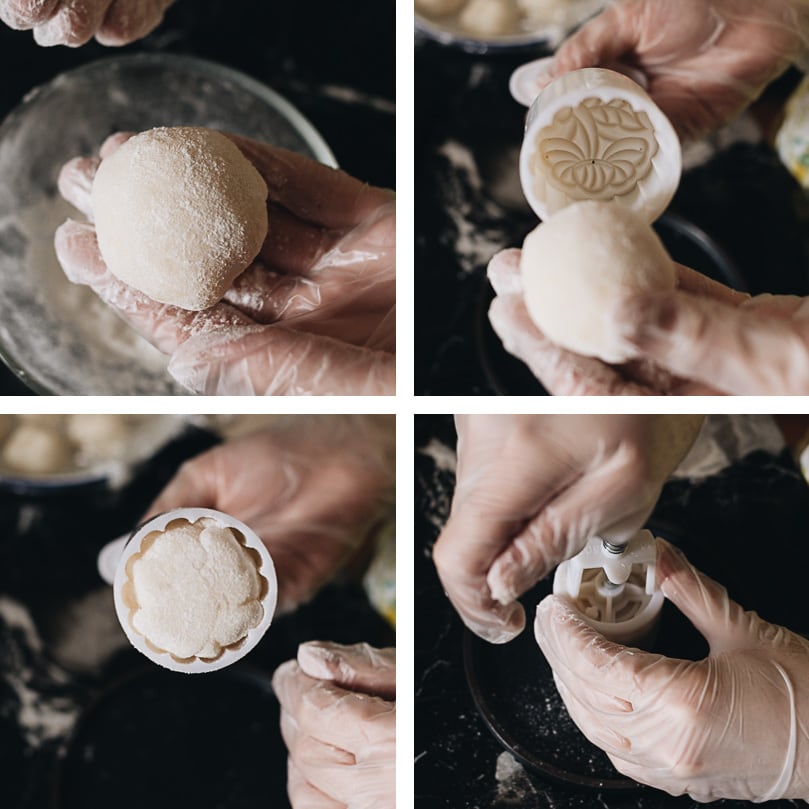
Note:
- Ideally, you should be using Gao Fen (cooked glutinous flour) to dust the mooncake. But since it’s hard to find, most recipes ask you to cook the glutinous flour in a pan for the coating. I found that step unnecessary because cooking the flour doesn’t eliminate its powdery raw taste. I used cornstarch to coat the mooncake, which is the approach usually used in mochi recipes.
- The pattern on the mooncake will fade a bit over time, which is unavoidable for any type of snow skin mooncake. Store-bought mooncakes use additives and are sometimes frozen to keep the mooncake in a perfect pattern. That’s why homemade ones might look less perfect, but they actually have a much better taste than the store-bought ones.


Frequently asked questions
- Why does my custard turn out too soft and I can’t shape it after chilling?
Make sure you bring the custard mixture to a boil (it should be bubbling if you stop stirring it for a moment), and let it boil while mixing it for a full minute. This is the key to make sure the custard is properly cooked and will firm up once chilled.
- Why does the mooncake skin harden once I stored it overnight in the fridge?
The mooncake skin will harden when it’s cooled. The best way is to let the mooncake rest at room temperature so the skin will turn a bit softer before eating.
If you do not plan to serve the mooncake the same day, I would keep them refrigerated in the wrapped ball form without molding them. You can mold them the next day before serving. So the patterns will stay more clear, and the mooncake skin will soften a bit too.
- The custard and the dough are too sticky and hard to work with. Should can I do?
The best way is to wear disposable gloves while working on the cooked dough and the filling. It keeps them from sticking and makes the workflow much smoother.
I hope you enjoy the recipe! Make sure you check out the video if you’re not familiar with the process. It is indeed a challenging project but the result is so rewarding!

More recipes for Mid-Autumn Festival
- Traditional Mooncake with Black Sesame Filling
- Dan Huang Su (Pastry Mooncake with Salty Egg Yolk, 蛋黄酥)
- Homemade Lotus Seed Paste (莲蓉馅)
- Mid-Autumn Festival Menu
- How to Make Red Bean Paste
- How to Make Shumai (烧麦, Steamed Dumplings)
- How to Make Chinese Dumplings from Scratch
Chinese Cooking Made Easy
Are you new to this website? This free email series is a great place to start. I’ll walk you through a few of my most popular recipes and show you how and why they work. You’ll quickly start to cook better Chinese food in your own kitchen.
Watch video
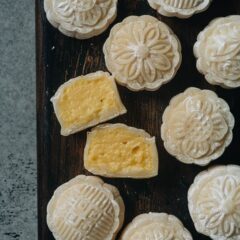
Snow Skin Mooncake with Custard Filling (冰皮月饼)
Ingredients
Custard
- 40 grams (6 tablespoons) cornstarch
- 5 grams (2 teaspoons) all-purpose flour
- 112 grams (1/2 cup) granulated sugar
- 5 large egg yolks
- 480 grams (2 cups) whole milk
- 30 grams (2 tablespoons) butter
- 1/2 teaspoon vanilla extract
Wrapper
- 120 grams (1 cup) glutinous rice flour
- 120 grams (1 cup) rice flour
- 120 grams (1 cup) cornstarch , and extra for coating the mooncakes
- 100 grams (3/4 cup) confectioners sugar
- 350 grams (1 1/2 cup) whole milk
- 55 grams (1/3 cup) vegetable oil
- 1/2 teaspoon vanilla extract
Equipment
Instructions
Make the custard
- Mix the cornstarch, all-purpose flour, and half of the sugar together in a small bowl.
- Place the egg yolks in a large bowl. Stir a few times to mix the yolks.
- Add the milk and the remaining half of the sugar into a small saucepan. Heat over medium heat. Stir occasionally to dissolve the sugar completely. Cook until it reaches about 120°F/ 49°C (no more than 150°F / 65°C). You might see a few bubbles here and there. If the milk starts foaming, it’s too hot.
- While the milk starts to get warm, add the dry ingredients (from step 1) into the bowl with the egg yolks. Whisk until it forms an even paste. Do not add the dry ingredients too early, because the sugar will change the texture of the eggs.
- Add the warm milk into the egg yolk mixture, about 1/4 cup at a time. Whisk constantly until the milk is fully incorporated into the paste. Continue to add more milk a 1/4 cup at a time and keep stirring, until it forms a thin, smooth mixture and all the milk is added.
- Return the mixture back into the pot (the one you used to heat the milk). Heat over medium heat and stir constantly while scraping the bottom (to prevent from burning), until the mixture thickens. Keep cooking and stirring, until it starts to bubble. Stop your spatula for a moment to make sure that the custard is boiling. Keep stirring and boiling for one full minute. This is important so the custard will be able to thicken after chilling.
- Remove the pot from the stove. Add the butter and vanilla extract. Stir to mix well.
- Line a large deep plate with plastic wrap. Place a large mesh strainer on top.
- Pour the custard into the lined plate over the strainer to smooth out the texture. Use a spatula to press the strainer if any lumps remain.
- Cover the custard with plastic wrap. Press the wrap against the custard, so it won’t form a skin once it’s chilled.
- Chill the custard in the fridge until it’s cooled completely, 2 hours or so. Or in the freezer for 30 mins.
Prepare the mooncake dough
- Prepare a large bowl that can fit into your steamer. Place a large strainer on top.
- In another medium-sized bowl, add the glutinous rice flour, rice flour, and cornstarch. Mix well with a fork.
- Line a large mesh strainer over the bowl and sift the confectioner’s sugar through it. Use your fingers or a spoon to press the sugar through if any lumps exist.
- Add the milk, oil, and vanilla extract into a small bowl. Stir to mix well.
- Use your fork to form a hole in the middle of the flour. Add 2 to 3 tablespoons of the milk mixture at a time. Stir until the liquid is incorporated into the flour completely. Repeat the process until it forms a very runny batter.
- Pour the mixture into the large bowl (you prepared in step 1) over the strainer. Press the lumps using a spoon. Once strained, the mixture will thicken a little bit.
- Prepare a steamer by pouring 1 inch (2.5 cm) of water into the steamer pot. Cover and heat over medium-high heat until boiling. Place the bowl with the batter into the steamer rack. Place the rack over the boiling pot. Cover and steam until the batter is cooked completely, 25 to 30 minutes. After 25 minutes, examine the dough by inserting a spoon into the middle. The spoon should come out clean, and the dough should feel very stiff.
- Once done, remove the lid, and transfer the steaming rack with the bowl onto your kitchen counter to cool off for a few minutes.
- Fold a kitchen towel a few times and place it on your working surface. Remove the bowl with the dough wearing oven mitts, and transfer the bowl onto the towel.
- Scrape the dough from the bowl and knead it using a spoon, until it forms a dough ball, 5 minutes or so.
- Transfer the dough onto a clean surface. Note, do not add any flour onto the surface or dust your hands with it. Knead the dough using your hands until it’s smooth, 5 minutes or so. The dough will soften once done.
- Form the dough into balls – Measure 25 grams of dough (about 1 round tablespoon) and use your hands to roll it into a ball. Place the dough balls into a container and cover. Chill in the fridge until the custard is ready to use.
Ingredient storage
- You can keep the dough and the custard filling refrigerated for a couple of hours, up to overnight, until ready to assemble. The dough will become a bit stiff if you chill it overnight. If you want the freshest taste, you should assemble the mooncakes the same day you make the dough and filling.
Assemble the mooncakes
- Once the custard is fully chilled, use a spatula to mix the custard again to even out the texture. This step will soften the custard a bit, but make it easier to scoop and shape.
- Form the custard into balls – Measure 25 grams of filling (about 1 round tablespoon) and use your hands to press and roll, until it forms a ball. I highly recommend wearing disposable gloves to help with this process, so the custard doesn’t stick to your hands.
- Transfer the filling balls into a plate and wrap it. Chill for another 30 minutes.
- Place the dough ball on a clean working surface. Use a rolling pin to roll it into an even, thin, round disc that is about 4” (9 to 10 cm) in diameter. Carefully remove it from the surface onto your palm.
- Place a custard ball in the center of the wrapper. Use your other hand to gather the wrapper onto the top of the custard filling. The dough sheet will start to form pleats and create a thicker layer. Try to pinch the extra dough together using your fingers, and pinch off the dough. The process will keep the mooncake skin even and thin, to create a better mouthfeel. Once done, place the mooncake onto a plate, pleated-side-down. Loosely cover it with plastic wrap to prevent them from drying out. Repeat the process to wrap the rest of the mooncakes.
To mold the mooncakes
- Install the pattern plate into the mooncake mold, with the pattern side facing downward. If you’re using the round shape, you can twist the lever of the mold so the pattern plate will snap onto the lever. It’s not required but it makes the process a bit easier.
- Dust the mooncake with a very thin layer of cornstarch. (*Footnote 1)
- Carefully place the wrapped mooncake balls into the mold, smooth surface against the pattern plate.
- Place the mold onto a clean, flat surface. Gently press the lever until the dough is against your table surface. Hold it for at least 30 seconds. It will help the pattern to form. Once done, push the lever to release the mooncake. Repeat the process to mold all the mooncakes.
- The mooncakes are ready to eat!
Storage
- Transfer the mooncakes into an airtight container. Store them in the fridge for 3 to 4 days. To enjoy the mooncakes with a better texture, transfer them to your kitchen counter and wait for them to return to room temperature. You can eat the chilled mooncakes, but the skin will be a bit stiff.
- Note, do not freeze the mooncakes. This will change the texture of the custard and make it very grainy.
Notes
- Most mooncake recipes call for Gao Fen (or cooked glutinous rice flour) for this step. If you have Gao Fen on hand, you can use it for dusting. If not, simply use cornstarch and the result will be good as well.
Nutrition

Did you make this recipe?
I’d love to hear how it turned out for you! Please take a moment to leave a 5-star rating ⭐️ and share your thoughts in the comments further down the page. It really helps others discover the recipe too.
The recipe was published in 2019 and updated in 2023 with a new video. I also slightly changed the dough recipe so it is easier to shape. The custard steps are clarified to solve the issue that it’s hard to shape after chilling.
Lilja Walter was a part of the Omnivore’s Cookbook team and worked closely with Maggie to develop and test this recipe.

Maria Paz
Hi! Thank you so much for the detailed and very graphic recipe. I just wanted to ask about what to use to dust the mooncake. You mentioned cornstarch as a better option instead of cooking glutinous flour, but should I cook the cornstarch as well? I guess I should but just wanted to make sure. Thanks again 🙂
Maggie Zhu
Hi Maria, actually the cornstarch is uncooked. I know it sounds strange, but it doesn’t affect the texture much since it’s just a very thin dust of cornstarch.
Everly
I compared this recipe to others and, there are shorter ways to make Mooncakes but they turned out pretty well overall
Sandi
I loved working with the dough on the day I made it. However, I refrigerated it overnight and then took it out the next day to get back to room temperature, and now my dough is impossible to work with 😰 I’ve managed to knead it so the dough sticks together, but once I try rolling it out and wrapping, it keeps breaking and splitting! What’s gone wrong here? Help please!
Maggie Zhu
I’m sorry to hear it. The dough is the easiest to work with when it’s freshly cooked. It will keep toughing up in the fridge if stored for too long. I’m afraid you might need to remake the dough.
Caroline
These are delicious! I subbed gluten-free flour for the flour in the filling and they turned out perfectly.
Eleanor
Custard tastes great and same with the dough but however, even after 1 hour of cooking it on medium heat, it did not firm up as I would hope. I left it in the freezer to harden it more so I could actually handle it but its still a very runny custard (like pastry cream). It would be great if you could provide a bit more guidance on this.
Everly
What I did to make the custard thicken was I put it on high (instead of medium heat) for about three minutes and then put it in the freezer for 30 minutes and my custard turned out great!
Jana
Hi! I’m going to try to make this in the next couple days. Really excited. 😀 Also, just so you know… the rice flour Amazon link goes to the moon cake mold instead.
Melissa Milonas
Thank you! We loved these! I would also add to your recipe for the custard part to describe how long to cook it for. I did not cook it long enough and ended up having to heat it again with additional cornstarch so that it was firm enough to roll into a ball. It was still delicious and worked out in the end but it was an added step. I did read through your reviews after and saw others had similar issues. It’s not a traditional custard texture so I think that’s where the mix up is. I am a pretty seasoned baker and have made pastry cream many times and so I was making it that consistency but it did not firm up in the fridge. Thanks again for this amazing recipe!
Maggie Zhu
I’m so glad to hear the recipe worked out for you! Yes I do got a lot of questions on the custard texture. It was tricky to provide a cooking time, because it can vary a lot due to the stove type and the output. That being said, your suggestion is super helpful and I will retest the recipe to get a cooking time. Maybe I also should shoot a video to demonstrate the process.
Thanks so much for your thorough feedback 🙂
Mavis
hi, can i use the filling recipe for traditional mooncakes instead? wouldn’t they make the dough soggy or crack upon baking?
Maggie Zhu
You can use other fillings such as lotus seed or red bean paste. You just need to make sure the fillings are cooked already since this recipe does not require baking (the skin is cooked first and you will serve it directly after the assemble).
Cherry
I loved this recipe, simple and easy to follow. I made the dough and left it covered in an air conditioned room (I live in SG), and I went back to work on it few hours later and it was the perfect texture to work with. Thank you for the recipe! It’s my first time making any sort of mooncake and am very happy with the results!
K
These were my first attempt at moon cakes. There were things that went a little strange like not really wet dough, but in the end it all turned out fine. Thanks for sharing the recipe.
Anita
Hi question. Is the recipe using regular glutinous rice flour or the Gao Fen? I have both available and not sure which one your recipe calls for? For gao fen, it still needs to be cooked/steamed? It’s just more fragrant?
Maggie
Hi Anita, I used regular glutinous rice flour in this recipe because Gao Fen is quite hard to find. If using gao fen, the entire recipe will be different.